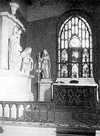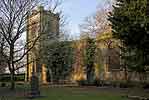For this church:    |
|
 Dado
panelling Dado
panellingwith thanks to the Thoroton Society |
Carved panelling
In 1661, as a memorial of the Restoration of the Monarchy, Sir John Musters had the old oak panelling taken from the dining-room in the old hall, and made up into dado seating for the body of the church. The dado consisted of two tiers of moulded raised-mitred panels, with a laid-panel above. There were thirty-two of these laid panels in all, and each one was carved in low relief with Renaissance ornamentation consisting of designs consisting of chimera, heads of Roman emperors in medallions, griffins, baboons, skulls of animals, grotesque heads, masks. All have scrollwork and attachments of spindlework and acanthus leaves. Similar panelling carved with “linen-fold” pattern was used for the choir seats.
In 1937, the Parochial Church Council allowed Colonel Chaworth Musters to purchase the oak panelling in the old church for £30.
Pulpit and squire’s pew
In 1906 Local Notes and Queries refers to church fabric in reminiscences by a Colwick resident referring to the church in the 1830s:
I saw him [the current squire Musters] on Sunday in the square seat on the north side known as Squire’s pew. It was before any organ had been placed in the church and the tunes were pitched on a peculiar looking instrument by one of the farmers in the village. The Rev Mr Thoroton was the officiating minister and remained so until the squire’s son William was eligible to succeed to the cure. In those days the pulpit was a three-decker of the most orthodox dimensions and as there was no vestry whereon the priest might robe. “Mr William” as he was called used to retire behind then pulpit to put off his surplice and on his gown during which operation the handsome clergyman was the observed of all those who dared to turn their faces from the organ loft. Like his father he had a fine ear for music and a rich deep bass voice which, during the later part of his time at Colwick he used with excellent effect. Indeed from the Squire’s pew and the minister’s desk there came as beautiful a quartette as was ever listened to, for the love and cultivation of music appears to be hereditary in the Musters family.
The pulpit was removed to the new church of St John in Colwick but was later destroyed because of woodworm.
 The chancel in 1910 The chancel in 1910with altar, east window and Musters memorial |
Altar
The mensa of the high altar in use in 1915 was a slab of grey marble with five consecration crosses that were Maltese in shape. The altar was removed to the new church of St John in Colwick but was later destroyed because of woodworm. The grey marble slab was retained and incorporated in a new altar.






